Introduction:
“Capernaum,” directed by Nadine Labaki, emerged in 2018 as a powerful and emotionally charged film that takes viewers on a journey through the harsh realities of life in the slums of Beirut. The narrative centers on Zain, a young boy who, despite his age, takes his parents to court for giving him life in the midst of poverty and suffering. In this comprehensive exploration, we delve into the film’s narrative depth, its portrayal of societal issues, the directorial prowess of Nadine Labaki, and the emotional impact that “Capernaum” has left on audiences worldwide.

Chapter 1: The Narrative Core
1.1 Zain’s Perspective
At the heart of “Capernaum” is Zain, a 12-year-old boy whose resilience becomes a testament to the indomitable human spirit. The film unfolds through Zain’s perspective, allowing audiences to witness the world through the eyes of a child grappling with the harshness of poverty, neglect, and societal indifference. Zain’s journey becomes a poignant exploration of the consequences of a society that fails its most vulnerable members.
1.2 The Decision to Sue His Parents
A central narrative thread is Zain’s decision to sue his parents for bringing him into a world of suffering. This bold and unconventional choice propels the story forward, prompting viewers to question the ethical dimensions of bringing a child into a life defined by destitution and despair. Zain’s journey through the legal system becomes a metaphor for the broader societal structures that perpetuate the cycle of poverty.

Chapter 2: Labaki’s Directorial Approach
2.1 Authenticity of Performances
Nadine Labaki’s directorial approach is characterized by a commitment to authenticity, particularly evident in the performances of non-professional actors. The film’s cast includes individuals from marginalized communities, adding a layer of realism to the storytelling. Labaki’s ability to extract raw and genuine performances contributes to the film’s emotional impact.
2.2 Handheld Cinematography
The director employs handheld cinematography to create an immersive experience, capturing the chaotic and unpredictable nature of life in the slums. The camera becomes a companion to Zain, navigating the narrow alleyways and crowded spaces, offering an intimate portrayal of his daily struggles. Labaki’s visual choices enhance the film’s emotional resonance, making the audience active participants in Zain’s journey.
Chapter 3: Societal Issues and Injustice
3.1 Child Neglect and Exploitation
“Capernaum” addresses issues of child neglect and exploitation, shining a harsh light on a reality faced by countless children worldwide. Zain’s experiences expose the vulnerabilities of those born into poverty, where childhood is marked by labor, limited access to education, and a constant struggle for survival. The film prompts viewers to confront the systemic injustices that perpetuate these conditions.
3.2 Immigration and Displacement
The narrative expands to explore themes of immigration and displacement, as Zain finds himself navigating a world where borders and legalities often dictate one’s opportunities. Labaki portrays the challenges faced by refugees and the bureaucratic hurdles that hinder their quest for a better life. “Capernaum” becomes a reflection on the global refugee crisis and the human cost of displacement.
Chapter 4: Maternal Love and Sacrifice
4.1 Rahil’s Character
Rahil, a character Zain encounters in his journey, embodies maternal love and sacrifice. Played by Yordanos Shiferaw, Rahil becomes a symbol of resilience in the face of adversity. The film explores the lengths to which a mother is willing to go to provide for her child, even in the harshest of circumstances. Rahil’s narrative adds emotional depth to the film’s exploration of family dynamics.
4.2 Zain’s Relationships
Zain’s relationships with other characters, particularly with an undocumented Ethiopian worker named Rahil, showcase the makeshift families that form in the margins of society. These relationships become a source of emotional support and solidarity in a world where traditional family structures often disintegrate. The film delves into the dynamics of chosen families and the enduring power of human connection.
Chapter 5: Symbolism and Religious Undertones
5.1 Capernaum as a Symbol
The title of the film, “Capernaum,” holds symbolic significance. Capernaum is a biblical city associated with miracles, and its use in the film adds layers of meaning. Labaki employs religious undertones to frame Zain’s journey as a modern-day odyssey, drawing parallels between the biblical narrative and the contemporary struggles faced by the film’s characters.
5.2 The Impact of Religion
Religious imagery and symbolism are woven throughout the film, exploring the impact of faith on individuals facing extreme hardship. Labaki does not shy away from depicting the complexities of how religion can both offer solace and be used as a tool of oppression. The interplay between faith and suffering becomes a thematic undercurrent, inviting viewers to reflect on the role of spirituality in the face of adversity.
Chapter 6: Hope and Resilience
6.1 Zain’s Quest for Justice
Zain’s decision to sue his parents, despite its unconventional nature, becomes a quest for justice and agency in a world that often denies these to the disenfranchised. The film balances the harsh realities of poverty with moments of hope, highlighting the resilience of the human spirit even in the bleakest of circumstances. Zain’s journey becomes a testament to the enduring power of hope.
6.2 The Closing Scene
The closing scene of “Capernaum” leaves a lasting impact, offering a culmination of Zain’s odyssey. Without revealing spoilers, the final moments of the film provide both a sense of closure and an open-ended invitation for contemplation. The ambiguity of the conclusion adds to the film’s emotional weight, leaving viewers with lingering questions about the broader societal issues it addresses.
Conclusion: A Call to Action and Reflection
In conclusion, “Capernaum” stands as a call to action and a mirror reflecting the harsh realities faced by marginalized communities. Nadine Labaki’s directorial brilliance, coupled with powerful performances and a deeply resonant narrative, creates a film that transcends its specific setting to become a universal exploration of human suffering, resilience, and the pursuit of justice.
Film Evaluation: “Capernaum” is a cinematic tour de force that compels viewers to confront uncomfortable truths about societal injustices. Nadine Labaki’s commitment to authenticity, coupled with a narrative that balances despair with moments of hope, creates a film that transcends its socio-political context. “Capernaum” is not just a film; it is a visceral experience that prompts reflection, empathy, and a call to action. In the realm of international cinema, “Capernaum” stands as a powerful testament to the art of storytelling and its capacity to ignite social awareness and change.


